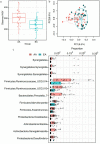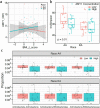Ethnic variability associating gut and oral microbiome with obesity in children
- PMID: 33596768
- PMCID: PMC7894456
- DOI: 10.1080/19490976.2021.1882926
Ethnic variability associating gut and oral microbiome with obesity in children
Abstract
Obesity is a growing worldwide problem that generally starts in the early years of life and affects minorities more often than Whites. Thus, there is an urgency to determine factors that can be used as targets as indicators of obesity. In this study, we attempt to generate a profile of gut and oral microbial clades predictive of disease status in African American (AA) and European American (EA) children. 16S rDNA sequencing of the gut and saliva microbial profiles were correlated with salivary amylase, socioeconomic factors (e.g., education and family income), and obesity in both ethnic populations. Gut and oral microbial diversity between AA and EA children showed significant differences in alpha-, beta-, and taxa-level diversity. While gut microbial diversity between obese and non-obese was not evident in EA children, the abundance of gut Klebsiella and Magasphaera was associated with obesity in AA children. In contrast, an abundance of oral Aggregatibacter and Eikenella in obese EA children was observed. These observations suggest an ethnicity-specific association with gut and oral microbial profiles. Socioeconomic factors influenced microbiota in obesity, which were ethnicity dependent, suggesting that specific approaches to confront obesity are required for both populations.
Keywords: Microbiome; disparity; minorities; obesity; socioeconomic factors.
Figures






Similar articles
-
Environmental and intrinsic factors shaping gut microbiota composition and diversity and its relation to metabolic health in children and early adolescents: A population-based study.Gut Microbes. 2020 Jul 3;11(4):900-917. doi: 10.1080/19490976.2020.1712985. Epub 2020 Jan 23. Gut Microbes. 2020. PMID: 31973685 Free PMC article.
-
Composition of gut microbiota in obese and normal-weight Mexican school-age children and its association with metabolic traits.Pediatr Obes. 2018 Jun;13(6):381-388. doi: 10.1111/ijpo.12262. Epub 2017 Dec 5. Pediatr Obes. 2018. PMID: 29388394
-
Association of Salivary Amylase (AMY1) Gene Copy Number with Obesity in Alabama Elementary School Children.Nutrients. 2019 Jun 19;11(6):1379. doi: 10.3390/nu11061379. Nutrients. 2019. PMID: 31248128 Free PMC article.
-
Trends in obesity prevalence and disparities among low-income children in Oklahoma, 2005-2010.Child Obes. 2014 Aug;10(4):318-25. doi: 10.1089/chi.2014.0022. Epub 2014 Jul 14. Child Obes. 2014. PMID: 25019336 Review.
-
The Role of the Gut Microbiota in Childhood Obesity.Child Obes. 2016 Aug;12(4):292-9. doi: 10.1089/chi.2015.0220. Epub 2016 Apr 8. Child Obes. 2016. PMID: 27058515 Review.
Cited by
-
Dysbiosis of the Subgingival Microbiome and Relation to Periodontal Disease in Association with Obesity and Overweight.Nutrients. 2023 Feb 6;15(4):826. doi: 10.3390/nu15040826. Nutrients. 2023. PMID: 36839184 Free PMC article.
-
Characterization of the oral and gut microbiome in children with obesity aged 3 to 5 years.Front Cell Infect Microbiol. 2023 Mar 29;13:1102650. doi: 10.3389/fcimb.2023.1102650. eCollection 2023. Front Cell Infect Microbiol. 2023. PMID: 37065198 Free PMC article.
-
Dietary fiber for the prevention of childhood obesity: a focus on the involvement of the gut microbiota.Gut Microbes. 2024 Jan-Dec;16(1):2387796. doi: 10.1080/19490976.2024.2387796. Epub 2024 Aug 20. Gut Microbes. 2024. PMID: 39163556 Free PMC article. Review.
-
Obesity influences composition of salivary and fecal microbiota and impacts the interactions between bacterial taxa.Physiol Rep. 2022 Apr;10(7):e15254. doi: 10.14814/phy2.15254. Physiol Rep. 2022. PMID: 35384379 Free PMC article.
-
Comparison of Periodontal Bacteria of Edo and Modern Periods Using Novel Diagnostic Approach for Periodontitis With Micro-CT.Front Cell Infect Microbiol. 2021 Sep 20;11:723821. doi: 10.3389/fcimb.2021.723821. eCollection 2021. Front Cell Infect Microbiol. 2021. PMID: 34616690 Free PMC article.
References
-
- Ng M, Fleming T, Robinson M, Thomson B, Graetz N, Margono C, Mullany EC, Biryukov S, Abbafati C, Abera SF, et al. Global, regional, and national prevalence of overweight and obesity in children and adults during 1980-2013: A systematic analysis for the global burden of disease study 2013. Lancet. 2014;384(9945):766–15. doi:10.1016/S0140-6736(14)60460-8. - DOI - PMC - PubMed
Publication types
MeSH terms
Substances
LinkOut - more resources
Full Text Sources
Other Literature Sources
Medical
